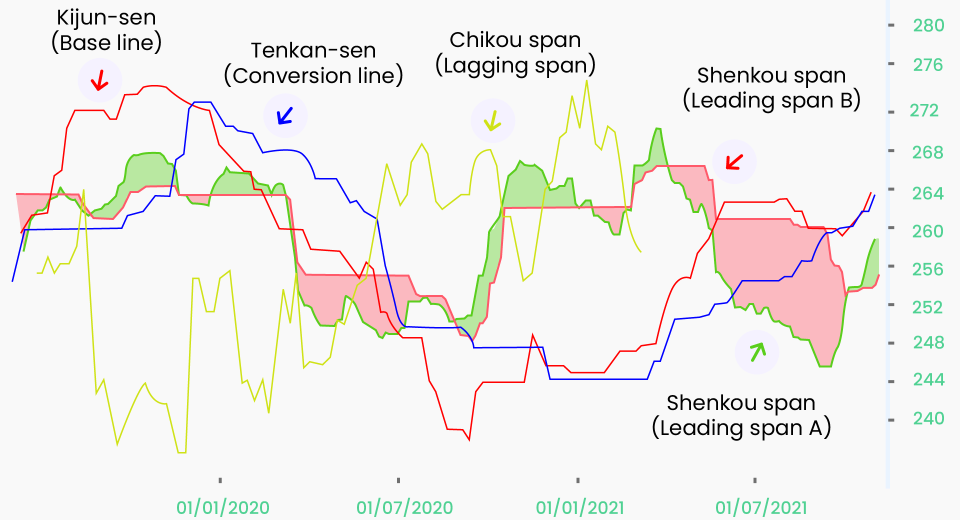The Bollinger Bands + RSI Trading Strategy

Traders often combine technical indicators to verify the signals and make smarter decisions. This not only gives them more confidence in their predictions, but also strengthens their strategy. This guide explains how to combine Bollinger Bands and Relative Strength Index, two of the most popular indicators to strengthen your trading strategy.
Relative Strength Index (RSI)
RSI is a momentum oscillator, which means that it reveals the rate of change of price movements. It oscillates between 0 and 100 and indicates oversold or overbought market conditions. It is plotted separately from the price chart, such that the horizontal axis shows time, and the vertical axis is marked 0 to 100 to measure the extent of the current price with respect to previous values.
RSI Calculation
RSI is the averaged ratio of positive (U) and negative (D) price changes.
U -> Average number of positive price changes.
D -> Average number of negative price changes.
RSI = 100 – (100 / (1+U/D))
Trading with Relative Strength Index Indicator
Standard oversold and overbought values are 70 and 30. However, you may change them to suit your trading strategy. Trading decisions are made as follows:
- When the oscillator lies between the limits, the market is considered flat, indicating a low short-term possibility of a trend reversal.
- When the RSI value is above 70, the market is considered overbought, and it is seen as a good time to open short positions (sell) to take advantage of the reversal.
- When RSI is below 30, the market is considered oversold, and you could go long (buy).
- Experts recommend you place stop loss and take profit orders at key Fibonacci levels and exit positions when the RSI signals that the market is moving opposite to the prediction.
Bollinger Bands (BBs)
BBs are among the most popular volatility indicators. There are three bands or lines on the price chart, making a channel that encloses the price movements. This indicator also helps to discover oversold and overbought markets while trading.
BB Calculation
Bollinger Bands are plotted using a reference line, which may be a simple moving average line (SMA) or exponential moving average (EMA) over N periods.
Middle Line: The EMA or SMA reference line.
Upper Line: EMA plus K times the standard deviation (SD) of price.
Lower Line: EMA minus K times the standard deviation (SD) of price.
Therefore, BBs are formed as:
BB = SMA ± K x SDSMA
Typically, the values for N and K are 20 and 2, respectively.
Trading with Bollinger Bands
A Bollinger Band trading strategy can signal entry and exit positions based on band expansion or contraction as well as price action behaviour with respect to the bands.
- The tightening of the bands is called a Bollinger Squeeze and signals an impending breakout. This strategy works well when the market is moving sideways.
- When either the upper or lower band is tagged (touched), the principle of mean reversion applies, indicating a reversal. This strategy works well when the market is trending.
- Using M-tops and W-bottoms is another method of identifying trend reversals while trading with Bollinger Bands.
Why Combine Bollinger Bands with Relative Strength Index?
BBs and RSI are like Mac ‘n’ Cheese in the trading community. The combination helps traders to identify an overextended market and the likelihood of a retracement. They differ in that BBs are a lagging indicator, while RSI is a leading one.
A good technical analysis strategy involves using multiple indicators such that a signal from one can be verified, as using a single indicator could generate false signals. For instance, RSI reacts too quickly during sudden sharp price movements. It may spike too soon and generate false signals. On the other hand, BBs may trigger a series of stop-outs and result in losses piling up when the price ‘walks the band,’ which it often does.
How to Combine Bollinger Bands with Relative Strength Index?
Analysts often combine a leading and a lagging indicator to devise a trading strategy to improve the strength and accuracy of signals. Here is how you can combine Bollinger Bands with Relative Strength Index:
A common technique to identify a strong signal is to check that two indicators are moving in the same direction. If the price of an asset hits the upper or lower band of the BBs, you can confirm the bounce with RSI. When BBs indicate an overbought market and RSI is above 70, it is a strong signal to sell. On the other hand, when BBs indicate an oversold market and RSI is below 30, it is a signal to buy.
Key considerations to improve signal quality while using BBs and RSI:
- Ensure that the Relative Strength Index hits the extremes in the first pullback.
- Ensure that the Bollinger Bands are wide and clean (price does not walk the band)
Play it Safe
Often new traders, who are not on top of news or perform sentiment analysis, wait for the RSI to hit 25 before opening a long position. This shields them from RSI’s tendency to react too fast to news or sentiment changes.
Consider the possibility of the market staying in an oversold or overbought state for a long duration when a major news or economic update is awaited, or after such an announcement. Despite the signal being correct, a trend reversal in the market may take much longer than usual.
Live trading involves real funds. So use a demo account to build and practise your chosen strategy in the preferred market. This will help you determine the most suitable timeframe, limit values for Relative Strength Index, and calculation parameters for Bollinger Bands.
Whatever your trading strategy, remember to adopt risk management techniques as markets can be unpredictable at times. Using stop loss and take profit orders helps limit losses and securing profits in case the market suddenly moves in a direction opposite to your speculation.
To Sum Up
- Relative strength index is a leading momentum oscillator that identifies the rate of change of price.
- Bollinger Bands are lagging indicators of volatility that identify asset prices that have deviated from the mean.
- RSI and BBs are combined to get strong reversal signals while trading oversold or overbought markets.
- RSI is used to confirm the signals generated by BBs.
Disclaimer:
All data, information and materials are published and provided “as is” solely for informational purposes only, and is not intended nor should be considered, in any way, as investment advice, recommendations, and/or suggestions for performing any actions with financial instruments. The information and opinions presented do not take into account any particular individual’s investment objectives, financial situation or needs, and hence does not constitute as an advice or a recommendation with respect to any investment product. All investors should seek advice from certified financial advisors based on their unique situation before making any investment decisions in accordance to their personal risk appetite. Blackwell Global endeavours to ensure that the information provided is complete and correct, but make no representation as to the actuality, accuracy or completeness of the information. Information, data and opinions may change without notice and Blackwell Global is not obliged to update on the changes. The opinions and views expressed are solely those of the authors and analysts and do not necessarily represent that of Blackwell Global or its management, shareholders, and affiliates. Any projections or views of the market provided may not prove to be accurate. Past performance is not necessarily an indicative of future performance. Blackwell Global assumes no liability for any loss arising directly or indirectly from use of or reliance on such information herein contained. Reproduction of this information, in whole or in part, is not permitted.




